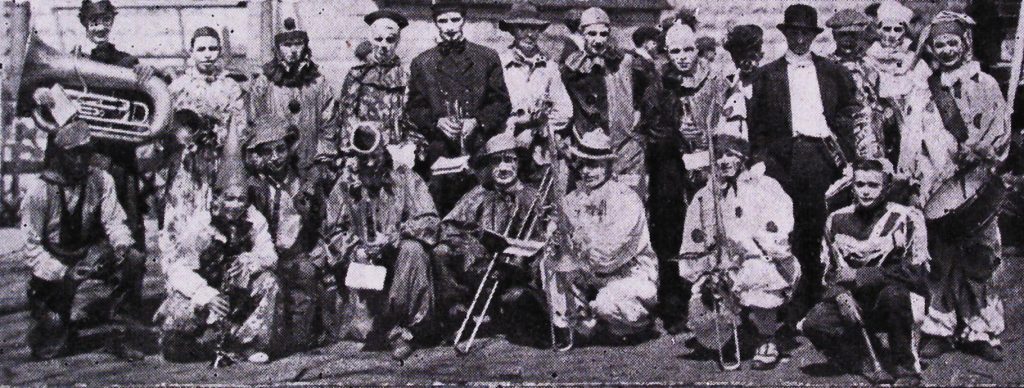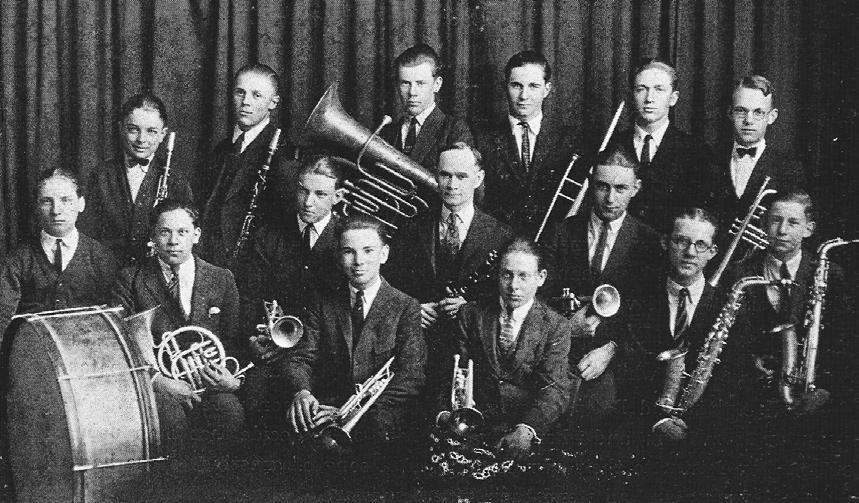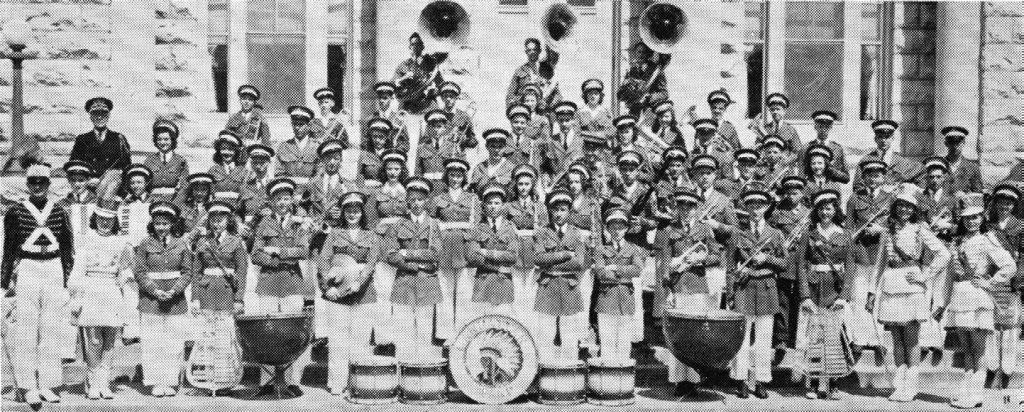By Janet (Krider) Duncan ‘58

The first Band pictured in the first Blue M (photo 1) looks like a group of kids “clowning around.” It waswas a group of kids clowning around; they were a part of the 1919 MHS Circus. The Circus was an all-school event produced by the student council each year between 1919 and 1924. Every Circus held a Circus Parade in which the Band marched, along with ‘wild animals’ and a preview of the main events and sideshow acts—tumblers, singers, dancers, and the ‘wild animals,’ all acted/ made by students and for which the public paid admittance. Circus was a fund-raiser. A large chorus and the orchestra were also part of the show. A kind of forerunner of today’s Variety Show, ‘Circus’ was an activity of many students in the Blue Ms.
The Clown Band apparently continued to play as a pep band at football games and basketball games. Recognizing this talent and interest, the school hired a professor of music to come down from Kansas State College to lead them (as was already being done for the school orchestra.) MHS students had turned their “clowns” into the MHS Band!

In 1923, the band was pictured in the Blue M as a regular school group (Photo 2) with director, math teacher Paul Evans. They played concerts as well as for all home football and basketball games, and traveled to Topeka and Lawrence for games.
By 1924, activities at MHS must have been humming. The first black player lettered in football that year, Forest Lorenzo Walker; three boys were elected cheerleaders, Raymond Dobbs, Paul Barger, and Karl Pfuetze; and Mr. R. H. Brown was hired as the first Director of Instrumental Music. Mr. Brown, who had started to direct District strings part-time in 1923, also owned the music shop on Poyntz Avenue which would later become Betton’s Music, and was the director of the Manhattan Municipal Band.
While instrumental music was not yet a class and no school time was used for practice, Mr. Brown encouraged students who were at all interested in an instrument to sign up for Band or Orchestra. He immediately enlarged the Band by including students from Manhattan Junior High, in the building next door, to play along side their Senior High counterparts.
The Circus was changed in 1924 into a Country Fair and given a more educational theme, but the “Boys Band” (as it was called in the ‘24 yearbook) retained its place in the festivities, along with orchestra (in which girls played) and chorus. They also won first place in a Sectional Music Tournament, the first contest for Band mentioned in the Blue Ms. The “Jazz Band” played at football and basketball games and for pep rallies.
In 1929, our MHS School Song, “Deep in our Hearts”, was written and adopted, and the Band’s and Mr. Brown’s popularity were high. “When Mr. Brown came to town five years ago,” quotes the ‘29 Blue M, “there were four people who could play instruments,” but by the spring of ‘29 they had a Band of 80, an Orchestra of 60, and Mr. Brown had “the respect and admiration of all.”

And that Band of 80 members wasn’t just any band: it was the Famous Oriental Band! (Photo 3)
The uniforms of the Oriental Band must have been splendid. Brilliantly colored with scarlet, blue and emerald green satin, their cummerbunds and white puttees would have flashed when they marched. In 1930, the Band boasted 68 regular players then swelled to 80 for parades—and judging from the photo below, some of these were girls. In addition to their regular schedule of football and basketball games, they marched and played in more places than ever—at the American Royal Show in Kansas City and in Manhattan’s Diamond Jubilee Celebration parade.
The Great Depression shows in the thin yearbooks of the 30s with fewer photos. Enthusiasm for the band did not dim in spite of the hardships, which included a polio epidemic in 1931. But a more classroom-type mission was developed, stated in part by the 1934 Blue M as The Purpose of the High School Band: “…to give students practice time and opportunity to play different instruments.” They still played at MHS football games and for pep rallies, although the big full band seems to have dropped basketball games during this decade. They marched in parades and at the American Royal Show in Kansas City, where the group won second place Honors in 1939. The band also had an opportunity each year to play at a Kansas State football game. Although not all the Blue M’s of the 30s specifically mentioned the Band, the decade ended with the 1939/1940 yearbook dedicated once more to the MHS Band Man, Mr. R. H. Brown.

After this start to the decade, a new 1941 Band (photo 4) emerged. At 72 members strong with military-style uniforms, three twirlers and a drum major, they had a completely new identity ready for the coming war years.